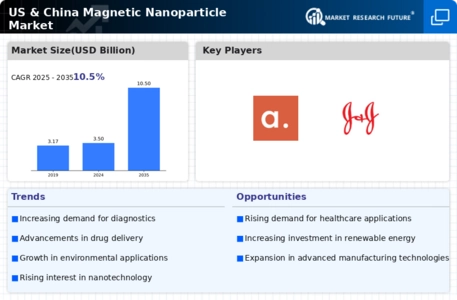Us China Magnetic Nanoparticle Size
US China Magnetic Nanoparticle Market Growth Projections and Opportunities
The American and Chinese markets of magnetic nanoparticles are affected by different market factors that influence its dynamics. For example, one of the main drivers in America is the increasing investment in R&D within nanotechnology. The demand for advanced medical diagnostics, targeted drug delivery and efficient imaging technologies has led to rise in growth of the magnetic nanoparticles market. This is augmented by growing awareness on environmental issues as well as clean energy alternatives that promote more applications for magnetic nanoparticles such as water treatment and energy storage.
On the contrary, China’s robust manufacturing industry heavily influences its magnetic nanoparticle market. It has a strong industrial base and therefore requires a huge demand for these particles in areas like electronics, catalysis, sensors among others. Further still, China pursues innovation and technological advancements which exemplifies in its “Made in China 2025” initiative, thereby contributing to fueling the growth of this sector.
Both countries are affected by regulatory policies and standards that govern the nanotechnology industry. In America, food and drug administration (FDA) regulations together with national nanotechnology initiative (NNI) guidelines largely determine how the country appears economically due to stringent attempts at ensuring safety and effectiveness when it comes to using magnetic nanomaterials medically or commercially.
Similarly; concerning regulation establishment on challenges and opportunities related to nanotechnology; china’s government has been proactive about it. For instance compliance with standard set by china national standards committee (CNSC) among other regulatory bodies is important for all those operating in Chinese markets of magnetic nanoparticles.
Moreover also global economic environment significantly affects US and China magnets nano-particle Markets hence economic fluctuation between two countries can affect research funding leading to export-import dynamics between two economies or even company collaboration between them. Changes geopolitical dynamic introduce uncertainties which necessitate strategic adjustments from actors in order to ensure their stability or competitiveness.
In addition; both countries’ markets for magnetic nanoparticles are driven by technology developments and innovations. Ongoing R&D efforts have led to introduction of new products and applications that are based on magnetic nanoparticles. The competition among firms in areas such as biomedicine, electronics and environmental science towards making breakthroughs has made the industry highly competitive with each firm trying to be at the forefront of innovative technology.
Similarly within the market, consolidation process may affect competitiveness while entry barriers plus presence of some key players will also determine how fierce rivalry is among firms. Attaining an edge in globalization world requires companies to invest in cutting-edge technologies, establish strong partnerships and effectively navigate through regulatory frameworks.






Leave a Comment